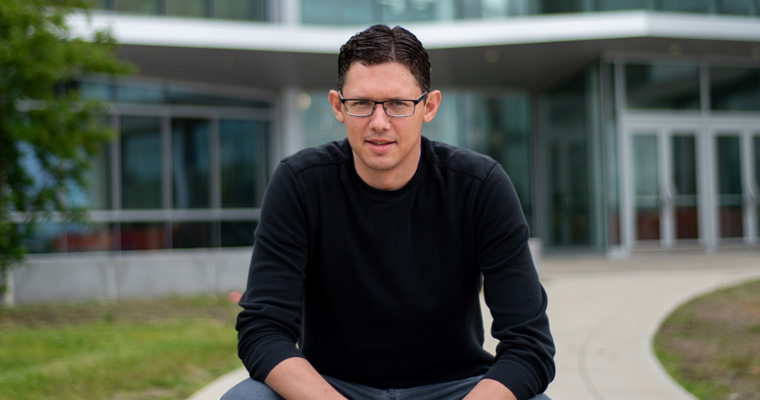Chemistry Professor Using $435,001 NSF Grant to Build Materials from the Ground Up
Jason Green to Share Work Through Open-Science Computational Notebooks

Associate Professor of Chemistry Jason Green and his research group are looking to understand how to use chemical reactions that cause molecules to assemble themselves into dynamic and responsive materials. Green says there are many reasons why you’d want to do this.
Green explains that dynamic or "active" materials have a number of potential applications, from sensors for biological molecules to drug delivery systems. These materials can modulate their structure in response to their environment’s temperature or pH and can even heal themselves if damaged. These properties make them well-suited for these applications.
“But, to fully realize this possibility, though, we need to better understand how chemical reactions affect the formation and destruction of material structure and look for ways to control these processes over time.” Green said. “Our first goal is to develop mathematical theory to predict material structure, lifetime, and yield when chemical reactions are responsible for whether the material exists or not. The ultimate goal would be to have a theory that accomplishes this directly from known molecular properties.”
Green is in the first year of a three-year $435,001 National Science Foundation (NSF) grant. By the time the grant ends in May 2022, he’s hoping to have developed mathematical equations and computational methods that, together with computer code, will predict the pathways a system will take in order to assemble a particular structure.
“As a material assembles, it follows a particular path as molecular ‘building blocks’ arrange and organize themselves. Our theory centers on these paths,” Green said. “Understanding these paths are important to energy and atom efficiency. But, there are still many basic questions. For example, what’s the most efficient way to build a material with the structure that we want? To answer questions like this, we use computer simulations and build models of systems that can be studied experimentally.”
Green is hoping to recruit additional undergraduate students to work with him to develop open-science computational notebooks written in the programming language Python and containing publicly-available, experimentally-relevant models for the assembly of these dynamic materials.
“As we develop answers to our scientific questions, we’re going to port them over to computational notebooks that demonstrate the idea. We’ll post them online so others can follow along,” Green said. “This is a way of reaching an audience that we might not have otherwise, but also incorporating undergraduate researchers and getting them familiar with the types of problems that we’re trying to tackle.”
Green says dissipative, or dynamic, self-assembly has practical promise as a simple technique to synthesize complex materials.
“The active materials we’re interested in need a supply of energy to exist. We’re interested in how the energy stored in chemical bonds is used to form the material structure. When the material forms, however, some of that energy is dissipated. So, we’re also interested in the mechanisms of how energy turns from one form into another and is lost as heat,” Green said. “Can we build a material with the exact structure, properties, and lifetime that we want in an energy-efficient way?”
This is Green’s eighth year at UMass Boston.
About UMass Boston
The University of Massachusetts Boston is deeply rooted in the city's history, yet poised to address the challenges of the future. Recognized for innovative research, metropolitan Boston’s public university offers its diverse student population both an intimate learning environment and the rich experience of a great American city. UMass Boston’s 10 colleges and graduate schools serve 16,000 students while engaging local and global constituents through academic programs, research centers, and public service. To learn more, visit www.umb.edu.
